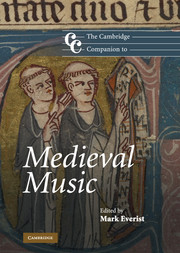Book contents
- Frontmatter
- Introduction
- Part I Repertory, styles and techniques
- Part II Topography
- Part III Themes, topics and trajectories
- 11 Music and liturgy
- 12 Vernacular poetry and music
- 13 Latin poetry and music
- 14 Compositional trajectories
- 15 Ecclesiastical foundations and secular institutions
- 16 Theory and notation
- 17 Music manuscripts
- 18 The geography of medieval music
- 19 Reception
- Notes
- Bibliography
- Index
19 - Reception
from Part III - Themes, topics and trajectories
Published online by Cambridge University Press: 28 September 2011
- Frontmatter
- Introduction
- Part I Repertory, styles and techniques
- Part II Topography
- Part III Themes, topics and trajectories
- 11 Music and liturgy
- 12 Vernacular poetry and music
- 13 Latin poetry and music
- 14 Compositional trajectories
- 15 Ecclesiastical foundations and secular institutions
- 16 Theory and notation
- 17 Music manuscripts
- 18 The geography of medieval music
- 19 Reception
- Notes
- Bibliography
- Index
Summary
The following survey distinguishes three types of music – plainchant, vernacular song, and polyphony – each with a very different reception history. Plainchant enjoyed an active and constantly evolving reception even in the Middle Ages; its modern reception history dates from the efforts, beginning in the early nineteenth century, to restore the medieval shape of the chant, a project that would bear fruit in the early twentieth century. New interest in vernacular song came in the wake of philological and historical research into European languages strongly under way by the eighteenth century. The unaccompanied melodies, free from any religious association, were subject to a variety of adaptations, often tinged by nationalism and ideology. Medieval polyphony was completely lost until isolated fragments came to light in the late eighteenth century, and it was well into the twentieth century before its outlines became clear.
Most medieval music was improvised, and so is lost or only dimly discernible through performance directions in music theory treatises. Works transmitted in musical notations required an active generation-to-generation updating to remain current. Liturgical chant – a repertory not as stable as we might think – was retranslated, sometimes undergoing recomposition. Notations for secular monophony and polyphony tended to fall out of use, since each generation was sufficiently occupied with the cultivation of its own new music. By the time we reach the point when scholars took a modicum of interest in the remnants of medieval music – the mid eighteenth century – no one could read the sources any longer. The problem was particularly acute for polyphony, usually notated in separate parts.
- Type
- Chapter
- Information
- The Cambridge Companion to Medieval Music , pp. 335 - 370Publisher: Cambridge University PressPrint publication year: 2011

